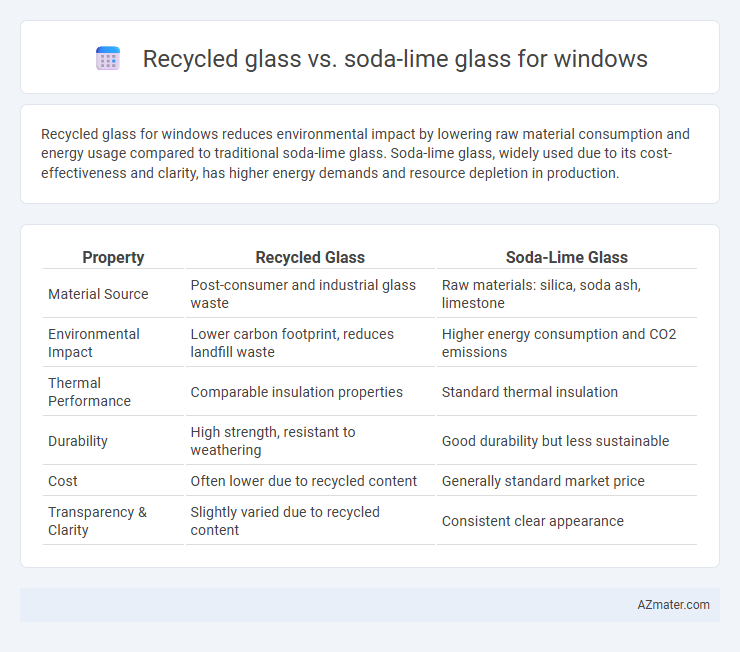Recycled glass for windows reduces environmental impact by lowering raw material consumption and energy usage compared to traditional soda-lime glass. Soda-lime glass, widely used due to its cost-effectiveness and clarity, has higher energy demands and resource depletion in production.
Table of Comparison
| Property | Recycled Glass | Soda-Lime Glass |
|---|---|---|
| Material Source | Post-consumer and industrial glass waste | Raw materials: silica, soda ash, limestone |
| Environmental Impact | Lower carbon footprint, reduces landfill waste | Higher energy consumption and CO2 emissions |
| Thermal Performance | Comparable insulation properties | Standard thermal insulation |
| Durability | High strength, resistant to weathering | Good durability but less sustainable |
| Cost | Often lower due to recycled content | Generally standard market price |
| Transparency & Clarity | Slightly varied due to recycled content | Consistent clear appearance |
Introduction to Window Glass Types
Recycled glass and soda-lime glass are two prevalent materials used in window manufacturing, each offering distinct environmental and performance benefits. Soda-lime glass, composed primarily of silica, soda ash, and lime, is the most common type due to its cost-effectiveness and durability. Recycled glass windows incorporate cullet, reducing energy consumption and raw material usage while maintaining comparable clarity and strength to traditional soda-lime glass.
Composition of Recycled Glass
Recycled glass used in windows primarily consists of cullet, broken glass fragments that retain the original soda-lime glass composition, including silicon dioxide (SiO2), sodium oxide (Na2O), and calcium oxide (CaO). The recycling process preserves these fundamental components while reducing the need for raw materials and energy compared to producing new soda-lime glass. This compositional consistency ensures that recycled glass maintains similar mechanical and thermal properties suitable for window applications.
Overview of Soda-Lime Glass
Soda-lime glass, the most common type of glass used in windows, consists primarily of silica, soda ash, and lime, offering excellent durability and clarity. Its widespread availability and cost-effectiveness make it the standard choice for residential and commercial windows, enabling easy recycling into new glass products. While recycled glass reduces environmental impact by lowering energy consumption during production, soda-lime glass maintains essential structural and optical properties ideal for window applications.
Manufacturing Processes Compared
Recycled glass windows utilize cullet, which is melted at lower temperatures (approximately 1200degC) compared to soda-lime glass (around 1500degC), leading to reduced energy consumption and lower carbon emissions during manufacturing. The soda-lime process requires raw materials like silica, soda ash, and limestone, while recycled glass repurposes previously melted glass, minimizing raw material extraction. Batch homogenization and melting in electric or gas furnaces occur differently due to cullet's faster melting rate, making recycled glass production more efficient and environmentally sustainable.
Environmental Impact Analysis
Recycled glass used in windows significantly reduces raw material extraction and energy consumption compared to traditional soda-lime glass, lowering carbon emissions by up to 30%. Soda-lime glass production involves intensive mining of silica sand and soda ash, contributing to habitat disruption and higher greenhouse gas output. Incorporating recycled glass not only curtails landfill waste but also minimizes the overall environmental footprint of window manufacturing through resource efficiency and reduced energy demand.
Durability and Strength Differences
Recycled glass used in windows maintains comparable durability to soda-lime glass but can exhibit slight variations depending on the melting and manufacturing process, affecting its structural integrity. Soda-lime glass, the most common form of architectural glass, offers consistent strength and resistance to impact due to its well-established production standards and chemical composition. While recycled glass contributes to sustainability, its strength under stress and long-term durability may require specific enhancements to match the performance reliability of traditional soda-lime glass in window applications.
Energy Efficiency Performance
Recycled glass windows demonstrate superior energy efficiency by reducing the embodied energy during manufacturing compared to traditional soda-lime glass. The lower melting point of recycled glass decreases energy consumption in production, resulting in a smaller carbon footprint. Additionally, recycled glass can achieve comparable thermal insulation properties, enhancing overall window energy performance.
Cost Comparison and Market Availability
Recycled glass for windows often offers cost advantages due to lower raw material expenses and reduced energy consumption during production, making it a budget-friendly alternative to soda-lime glass. Soda-lime glass, the most common window glass type, benefits from mass production and extensive supply chains, ensuring widespread market availability and competitive pricing. While recycled glass availability can be limited by regional recycling infrastructure, soda-lime glass remains more consistently accessible across global markets.
Applications in Modern Architecture
Recycled glass is increasingly used in modern architecture for window applications due to its sustainability and ability to reduce carbon footprint, making it ideal for green building projects. Soda-lime glass remains the most common choice, offering durability, cost-effectiveness, and excellent thermal insulation properties essential for energy-efficient windows. Combining recycled glass with soda-lime formulations enhances environmental benefits while maintaining structural integrity and aesthetic versatility in architectural designs.
Choosing the Right Glass for Windows
Recycled glass window panes offer eco-friendly advantages with reduced carbon footprints and lower energy consumption during production compared to traditional soda-lime glass. Soda-lime glass remains the industry standard for windows due to its high durability, cost-effectiveness, and excellent clarity, making it suitable for most residential and commercial applications. Evaluating thermal insulation, environmental impact, and budget constraints helps determine whether recycled glass or soda-lime glass is the optimal choice for window installations.

Infographic: Recycled glass vs Soda-lime glass for Window
 azmater.com
azmater.com